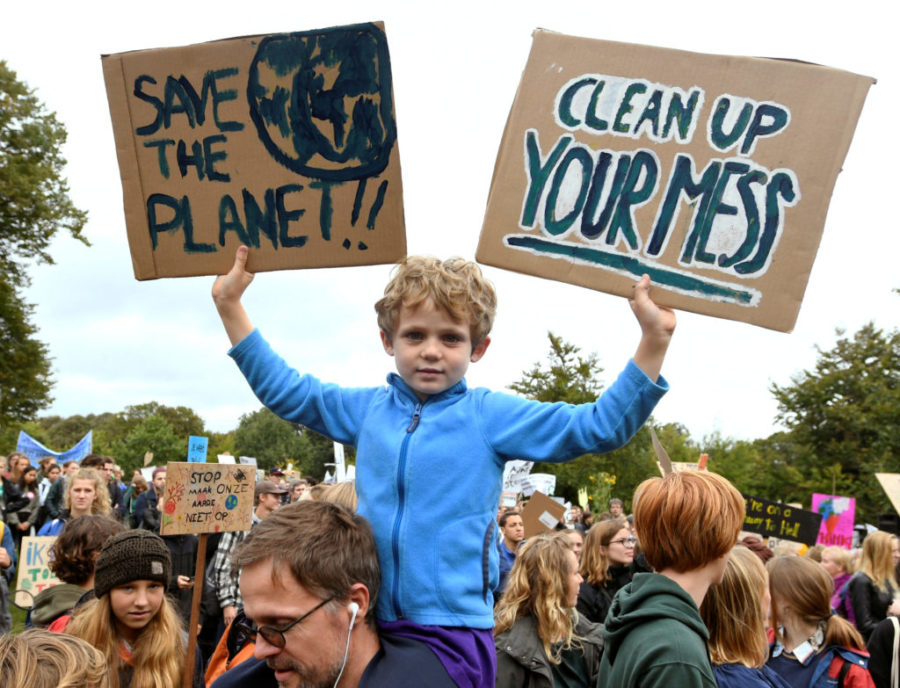Atmospheric Destabilization and Our Responsibility
A child holds placards during a protest march to call for action against climate change, in The Hague, Netherlands September 27, 2019. REUTERS/Piroschka van de Wouw
March 19, 2021
Global Warming. Climate Change. Atmospheric Destabilization. All names for the same crisis; the steady collapse of our world under the extreme effects of pollution and increased greenhouse gases.
Taking a step back from the scary reality that is climate destabilization, it’s important to understand how we put ourselves in the situation we are in. Worldwide pollution has come hand in hand with technological advancements. Rising since the early 1800s and the Industrial Revolution, and sharply since the end of World War II and its post-war economic boom, pollution rates have soared. Industrialization with the use of fossil fuels has caused nearly irreparable damage on our ozone layer, a layer in our atmosphere that absorbs the sun’s ultraviolet rays. For the most part, industry has ignored its effects on our planet and its ecosystems in favor of less expensive production. This widespread ignorance has led to our current situation.
Now you may be asking, “What exactly is our current situation?” Let me lay things out for you. Countless species are in danger due to their ecosystems collapsing. Pollution and industrialization has choked out many organisms that were unlucky enough to live in the wrong forest or swamp. Our oceans are not only rising but they are also warming. The rising directly affects us; we may no longer be able to live on coasts after they’ve weathered away. “Since 1994, on average, the earth has lost 400 billion tons of ice from its glaciers,” said Bill Nye in a National Geographic video. This swelling has flooded coastal regions across the globe.
The warming directly affects ocean life and in turn indirectly affects us. Ocean life built on living at certain temperatures is dying off because they can’t find waters cold enough to support them. For example, a large reason that shark populations are decreasing is because of the increase in ocean temperatures. Not only does it directly affect them and their regular body temperatures, but it has decreased their food supply, making it a struggle to satisfy their appetites. The final piece with our oceans is ocean acidification. Ocean Acidification is essentially the process of carbon dioxide interacting with salt water. This process is natural, but with increased carbon production comes increased acidification, destabilizing bottom feeder species in the ocean food chain. According to Nye, around one billion people are reliant on the ocean for their food. With warming ocean temperatures and increased ocean acidification, their food supply is at jeopardy.
This destabilization has had a dramatic affect on the weather events we experience as well. Not only have we seen an increase in the events themselves, but also in their severity. Hurricanes have become more frequent, and with a hotter atmosphere, have more fuel to last on land causing major damage. Droughts are more extreme, lasting longer and hotter than ever before. Even a couple of months into this year we have seen examples. Winds that usually maintain the northern polar climate broke down, allowing for the polar winds to dip down freely, covering states like Texas and Oklahoma in snow. We all watched as Texas froze, unprepared for such a decisive strike of polar force.
Then there is the Metronome countdown. Replacing what used to be a regular digital clock is a large 15-digit countdown clock plastered on the side of the Metronome Building in downtown New York City. This art installation serves as a sign, counting down to when effects on our climate will become irreversible. The daily reminder acknowledges just how close to the brink we are.
So, what can we do? Well, there is actually a lot that we still can do to help at least slow the conditions our planet is under. We can recycle. The three R’s are a great way you can contribute in an easy way. Even doing something as simple as utilizing the recycling bins behind our homes can have some positive influence. Another simple thing we can do is ride share. Many cities offer express highway lanes for carpooling. But even when those aren’t available, we can still give other people rides or take public transportation. This too helps reduce our carbon footprint. Even more simple is being conscious of water usage. Turning off the faucet while brushing your teeth and taking shorter showers help to maintain fresh water supplies. We can be conscious consumers, aware of the products we buy. Quickly researching everyday goods will show how many options there are that are recyclable or made from reused materials. Bigger ways we can help is invest in environmentally friendly businesses and use renewable energy options. Things like solar panels and wind harnessing energy sources have become more affordable and tremendously reduce personal carbon emissions.
I’ve grown up in a world where the indisputable evidence that there is a climate crisis is painfully evident. Yet, people still ignore basic science, refusing to believe based on political or selfish reasons. Enough is enough. The signs are here, there, everywhere. All around us we can see our beautiful planet, the one place we can all call home, slowly suffocating. What I will ask you, the reader, is this: research. Educate yourself on the effects we are experiencing everyday, the effects we are causing. Learn more about what we can do to help slow the effects of climate change. Despite a bleak outlook, there is still much we can do. When I was little, teachers used to sing to my classmates and I a song that went, “Clean up, clean up, everybody everywhere!” It’s time for all of us to clean up. Everybody, everywhere.


